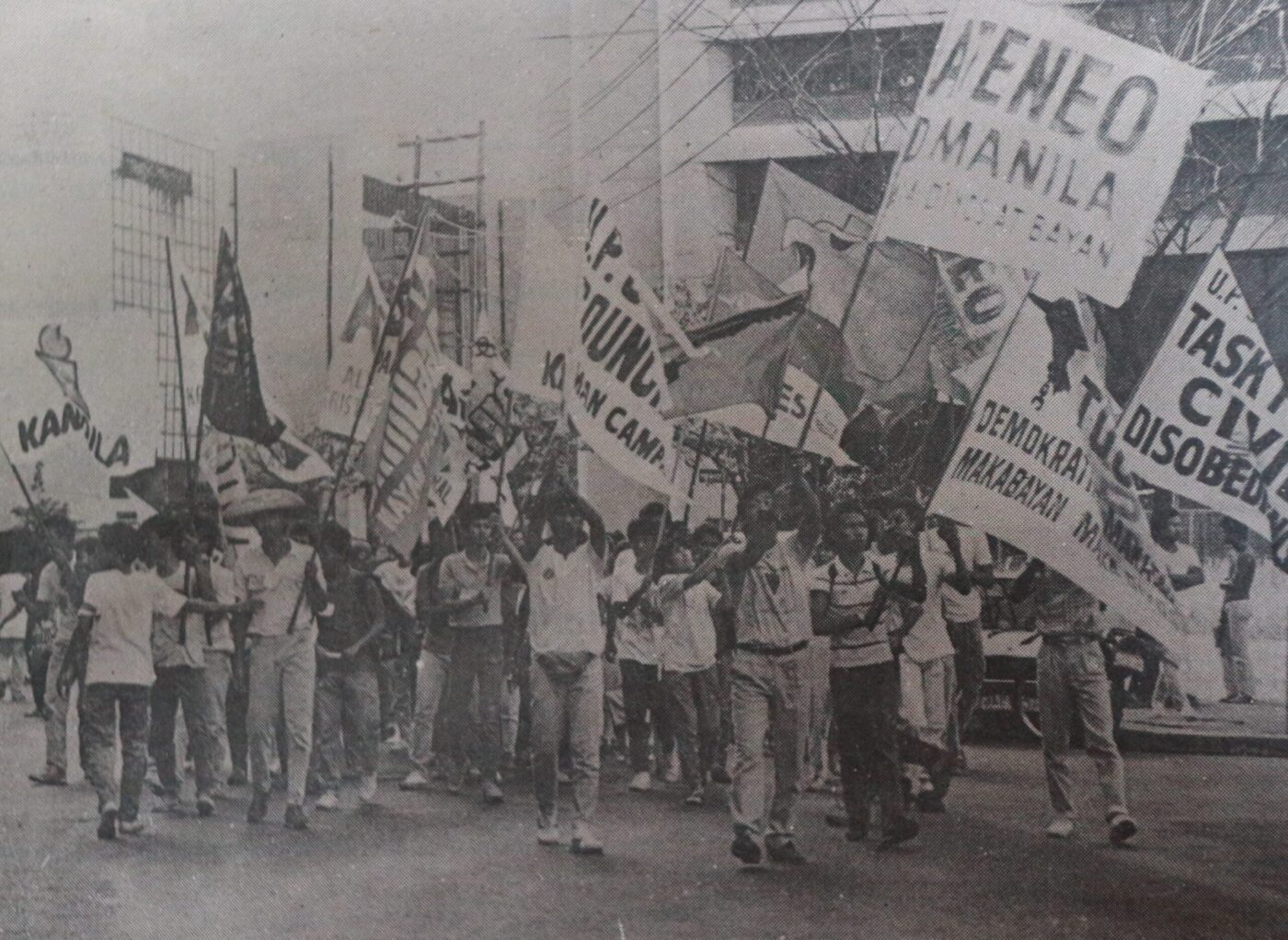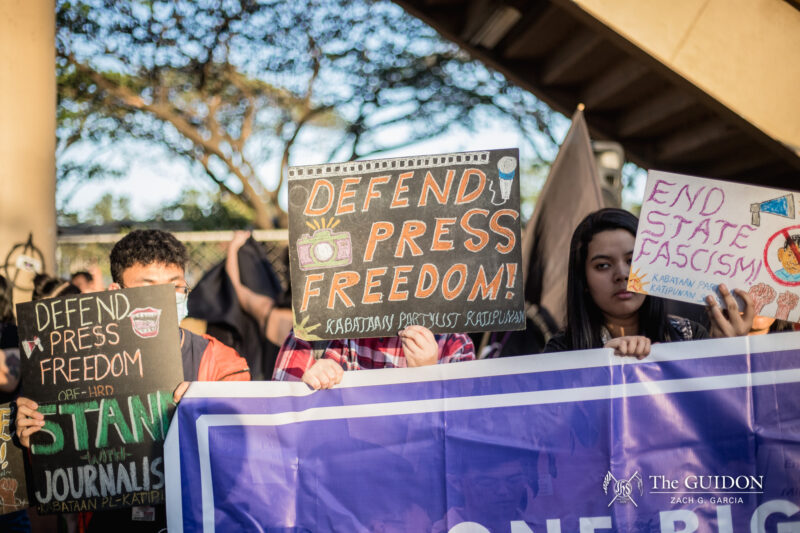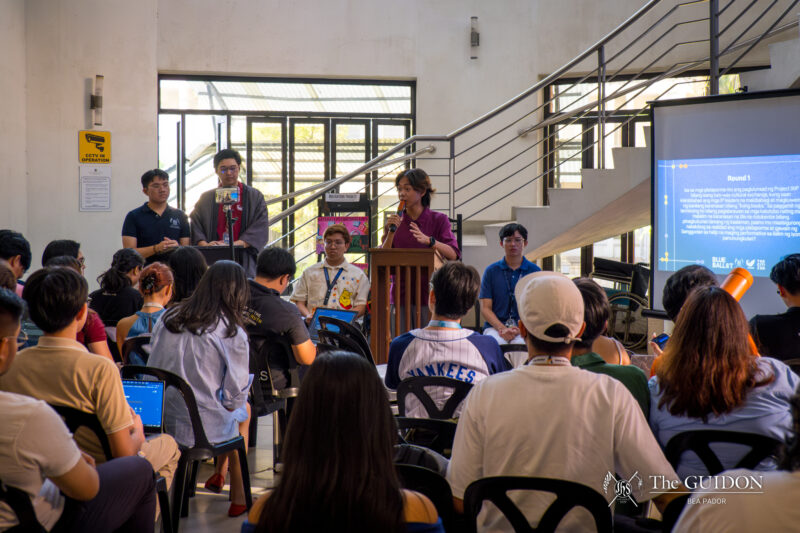Editor’s Note: The following article is taken from The GUIDON Volume 53, Number 5, originally published March 1986.
IMMEDIATELY AFTER the murder of Ninoy Aquino on August 21, 1983, I sent Newsweek a letter deploring it as a blow to democracy and to our fallen autocrat Ferdinand E. Marcos’s calls for national reconciliation. I said that “as a 17 -year-old student who doesn’t usually believe in politicians, but rather in ideas and ideals, I too share my countrymen’s sadness and unquenched hopes.” I was then just two months as a college freshman at the Ateneo de Manila, a true-blue “martial law baby” weaned on “New Society” textbooks and the Marcos epic. I knew no other President then except Ferdinand Edralin Marcos and his ex-beauty queen First Lady, the queenly Imelda. That Sunday killing of Ninoy, I was to later realize, shattered the magical trance that gripped the nation in desiccating authoritarian rule. That singular act of heroism, coming home in spite of death threats, moved me as it had awakened millions of Filipinos, especially the quiescent middle class. Mass demonstrations and the biggest funeral in Philippine history would quickly unfold in the succeeding weeks of endless astonishments. The Filipino nation was unshackled from fear and lethargy by the image of a blood-strained corpse of one who had said that “the Filipino is worth dying for.”
Once, my classmate Rafael Ongpin (his pa is the new Finance Minister, Jaime Ongpin) told me of a foreigner who said that our society was made up of one dictator and 50 million cowards. It wasn’t an accurate observation, for the First Couple Ferdinand and Imelda had built their “New Society” on the iron decrees of a decade of martial rule, political genius and, if one is to believe the First Couple’s superstition, sheer luck.
In the confusing midst of strange black-outs, panic-buying, bank runs and wild rumors after August 21, the already ailing economy fell apart. Marcos was rumored to have been gravely ill, even dead. For me it was a time of personal conversion. I had admired Marcos the war hero (28 World War II medals), brilliant lawyer (topping the bar exam with a record score) and political virtuoso (running for his first election after the war, he asked his Ilocos [province mates] to vote him into Congress and promised he’d be President in 20 years). I had admired Imelda Romualdez Marcos, the First Lady who was transformed from the “Rose of Tacloban” into the powerful “Iron Butterfly” who was her husband’s co-ruler. I was disillusioned. The afternoon of August 28, Monday, on my way home from school, I decided to pass by Sto. Domingo Church where Ninoy’s corpse lay. Long lines of people from all walks of life, patiently waiting to see the martyr, snaked through the streets. Ateneo held a special mass inside for its fallen alumnus. The church was crowded; the only way I could see the martyr was by lining up outside for an hour. I finally reached the corpse in front as the crowd [sang] a final hymn. The puffed face of Ninoy looked grotesque where the bullet passed through his skull, and the dried blood on his once-white shirt made it look like a khaki military uniform. Outside, a poor old woman clutched a color photo of the corpse. In her grief-stricken face I saw the agony of the Filipino nation, a nation that through Ninoy’s death was reborn in courage and selflessness. “Hindi ka nag-iisa” became the slogan of solidarity, yellow became the protest color (a welcoming party at the airport waited to give the man yellow flowers, inspired by the old pop song Tie a Yellow Ribbon about an ex-convict’s homecoming) and the stirring Bayan Ko became the battle song.
The Beginning of the End
When the sham trial of the Aquino-Galman double murder was closed in late 1985, it seemed the abuse of the national conscience by the powers-that-be was already unconscionable. In our Mercantile Law class, I remember we complained over the acquittal of all the accused by the Sandiganbayan. Our class spontaneously spent one and a half hours discussing the legal nuances and national impact of this blatant travesty of justice. After an interchange of views with an equally angry teacher, a classmate then posed a bitter question, “Why are we studying the law?” There was silence as we pondered over the sad but true question, knowing that outside the quiet halls of the Ateneo was a society mired by unbridled corruption, violence and suffering which made a mockery of our pretensions to democratic and legal traditions.
Like a shot of lightning out of a gathering storm, Marcos announced the calling of a “snap” election on live American television one night. He wanted to prove his mandate to skeptical America and the world, and he was supremely confident. He hoped to turn the tide of doom and decay precipitated by Ninoy’s 1983 murder. I caught the news on the late night T.V report. “Great decisions are made for us as we make them,” the wily and frail (due to a suspected systemic lupus erythematosus) autocrat once declared. The next few months were times of great decision that would radically alter the course of the nation’s history.
On the strength of the one million signatures from a cross-section of the nation, the quiet widow of Ninoy, Corazon “Cory” Aquino was soon thrust into the political cosmos as challenger to Ferdinand Marcos. Uniting the fragmented opposition in an 11th hour consensus, Cory evolved into a surprisingly strong presidential contender in the campaign. The quiet dignity and moral courage she showed after Ninoy’s death won her the people’s admiration. Weeks before her formal candidacy, I remember seeing her at the [ground floor] of her family’s Cojuangco building in Makati. I had just gone to see her amiable son Noynoy at Mondragon on a possible advertisement for The GUIDON, and I passed by the Ninoy exhibit. As I entered the building, I heard a tape-recorded speech of the man recapturing his staccato bursts of idealism and eloquence. Other memorabilia, like rusting dumbbells and his clothes were on display. Cory seemed shy as I saw her chatting with a daughter at a desk near the door; she must have been discomfited by the thought of being one of Ninoy’s real memorabilia. As I was walking out, I debated whether to approach her to tell her she should run for President. Even then, rumors of a possible snap election were in the air. But later on in her hectic campaign, where the wispy miracle lovingly called Cory drew massive crowds and sympathy, I knew my instincts then must have been shared by most of the Filipino people. At the special Intercon speech she gave to business leaders on February 3 where she called Marcos a “Filipino Pharaoh,” and outlined her first hundred days, the Filipino, Chinese, and foreign businessmen gave her 39 thunderous rounds of applause and two standing ovations. The next day, Marcos wound his way to the same ballroom through a comparatively sparse assemblage and polite applause. It was a rather somber ambience, for a seasoned politico campaigning for his biggest battle in a meteoric career that spanned the life of a post-war republic. The fire in the once young and visionary Marcos eyes were now replaced by a teary stare he claimed was caused by a flu. He had deteriorated in health due to an oft-denied disease, but more significant, he seemed broken in spirit. Televised live on government [T.V.], he labored through his meandering extemporaneous speech, lashing at his rival (while never mentioning her by name), defending his war record (I noted the Japanese Chamber of Commerce President shaking his head as Marcos claimed Emperor Hirohito had even devoted nine pages of his memoirs to the exploits of his Maharlika guerrilla unit) and gifting the disenchanted business leaders with a series of decrees he signed right at the speaker’s podium. He also altered a scheduled February 6 debate on American Ted Koppel’s t.v. show, citing legal impediments. I knew then that he’d lost the middle class vote, the Roman Catholic Church, the urban vote, the confidence of business, and even lost a substantial following from the usually quiet Filipino-Chinese business community. As he walked out of the lobby downstairs, a Filipino businessman carried his baby near the autocrat and shouted “Greet the lolo!” Marcos smiled, but looked tired. I saw him walk [past] me in a sick man’s gait for the last time, I took one final close up snapshot as he waved to the gathered crowd and settled into his Mercedes limousine. Late that noon and night, I was at the rooftop of the Manila Hotel with scores of foreign media people watching Cory Aquino’s final miting de avance rally. The panoramic sight of the sea of humanity in the darkening Manila Bay horizon left one breathless. An NBC reporter, standing fearlessly near the unrailed edge and using the multitude below as backdrop, told American t.v. that Cory had rejected Marcos’s last minute offer to debate on the government t.v. channel 4.
Sen. Lugar, whom I bumped into in a Manila Hotel elevator after his February 6 speech that day before the election, represented the keen American interest in the polls. The whole world, with its army of journalists and observers, practically placed the country under a microscope. It was a battle royale, and for most Filipinos, a stirring drama. A wily and powerful autocrat with his audacious First Lady was battling for the soul of a nation against an inexperienced and religious housewife, a Genghis Khan vs. a populist Joan of Arc. Jamie Cardinal Sin described it [as] a contest between the forces of good and evil.
The February 7 election was unprecedented in fraud and violence. From the corridors of Malacanang [to] the Cojuangco building, the Batasan’s history was in the making. Following the snap polls, the Filipino nation, through brave NAMFREL and other freedom vigilantes who guarded the ballot with their loves, came of age as a freedom-loving nation. Citizens forming human barricades against goons; the sight of nuns hugging ballot boxes like the sacrament; this convergence of faith and courage brought to the fore a shining moment in our national history. The world stood back in awe.
The February Revolution: A Nation Up in Flowers and Rosaries
The Bishops’ call for a “non-violent struggle for justice” was the [death knell] to the Marcos regime’s credibility, encouraging Cory’s crusade for democracy in spite of the flawed snap polls. Marcos, as expected, won in the COMELEC and Batasan tallies with slim margins. The NAMFREL count showed a clear Cory victory. The Sunday of Feb. 16 Cory held a gigantic “People’s Victory” rally where she outlined the beginning of a non-violent protest campaign with the boycott of Marcos crony banks, press and companies like San Miguel. Earlier in the month I experimented buying some blue chip stocks with my savings, and one of the firms I chose was San Miguel. I was shocked to see on Monday, February 17, the value of San Miguel stocks tumble. Cory called for protests, and it was a time for personal sacrifices.
It seemed Marcos was running out of luck. On Feb. 7 (his lucky number) his expected victory slipped away and ended in a hollow Batasan proclamation. On the 22nd, the Enrile-Ramos revolt exploded, trickling in through the airwaves of Radio Veritas that fateful Saturday night. Four remarkable days of the February Revolution commenced. Heeding the call to the streets of Cardinal Sin, Filipinos spilled into the streets to cast their lot in the democratic struggle. The country was up in flowers and rosaries. People massed to stop advancing tanks and marines. Bewildered soldiers were embraced by citizens and offered bread. It was an inspiring miracle that further crumbled the autocrat’s already tenuous hold to power.
The Empty Grandeur of Malacanang
When the autocrat and his Lady took a last ditch effort to inaugurate his fourth term inside the barricaded Malacanang Palace, I really thought that he’d once more pull off his bluff. It was a nauseating thought. Even as the last of the t.v. stations were overpowered by rebels in the middle of his inaugural, he persisted through the charade. Later coming out the balcony to greet his loyalists in the palace [grounds], and with his First Lady Imelda in a white terno by his side, the autocrat was said to have spoken with a clenched fist throughout his last official act. When I heard on radio at 9:05 pm that Feb. 25 that he had fled under cover of darkness, I felt gratified that the first successful Philippine revolution was won with non-violence, that there was now hope for the nation. I was also saddened as I waded through the crowd in the open portions of the palace grounds the next morning and sneaked into the heavily guarded main palace building which was spared the mob’s fury. Twenty years of the nation’s life were wasted; a promising politician’s career had started with brilliance, the stuff of which legends are made, only to degenerate into corruption, greed and demented lust for power. The glaring opulence of the palace chambers, although striped of its real grandeur by the fleeing First Family, seemed obscene in our poor society: the First Lady’s ultra-modern disco, the big bowl of half-eaten caviar in the mahogany dining table, the lavish chandeliers, the ubiquitous portraits of Imelda. Near the bed of the sick autocrat’s more austere bedroom, replete with oxygen tank and hospital paraphernalia, lay the desolate World War II soldier’s helmet of a once-promising young Marcos who as a student called President Quezon “a dictator” and who had once promised his country greatness.







